Links and write-ups about beautiful things from around the web!
-
Google X Cat Image Recognition
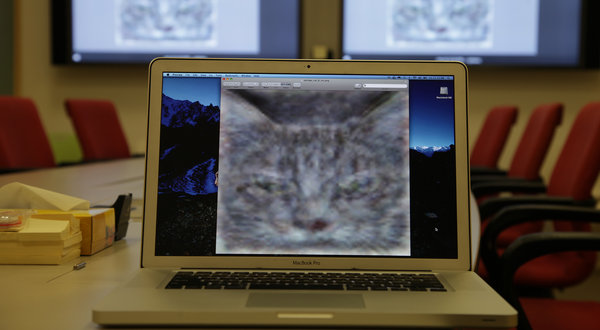
The Internet has become self-aware, but thankfully it just wants to spend some time scrolling Tumblr for cat videos. From the NY Times, How Many Computers to Identify a Cat? 16,000:
[At the Google X lab] scientists created one of the largest neural networks for machine learning by connecting 16,000 computer processors, which they turned loose on the Internet to learn on its own.
Presented with 10 million digital images found in YouTube videos, what did Google’s brain do? What millions of humans do with YouTube: looked for cats. The neural network taught itself to recognize cats, which is actually no frivolous activity.
(Photo credit: Jim Wilson/The New York Times)
-
Slime moulds work on computer games
Hey, that’s not a very nice thing to call game developers! Oh, you mean literal slime molds…
British computer scientists are taking inspiration from slime to help them find ways to calculate the shape of a polygon linking points on a surface. Such calculations are fundamental to creating realistic computer graphics for gaming and animated movies. The quicker the calculations can be done, the smoother and more realistic the graphics. …
Adamatzky explains that the slime mould Physarum polycephalum has a complicated lifecycle with fruit bodies, spores, and single-cell amoebae, but in its vegetative, plasmodium, stage it is essentially a single cell containing many cell nuclei. The plasmodium can forage for nutrients and extends tube-like appendages to explore its surroundings and absorb food. As is often the case in natural systems, the network of tubes has evolved to be able to quickly and efficiently absorb nutrients while at the same time using minimal resources to do so.
The Internet will some day be a series of (feeding) tubes?
-
Dna Sans Nanoscale Typeface
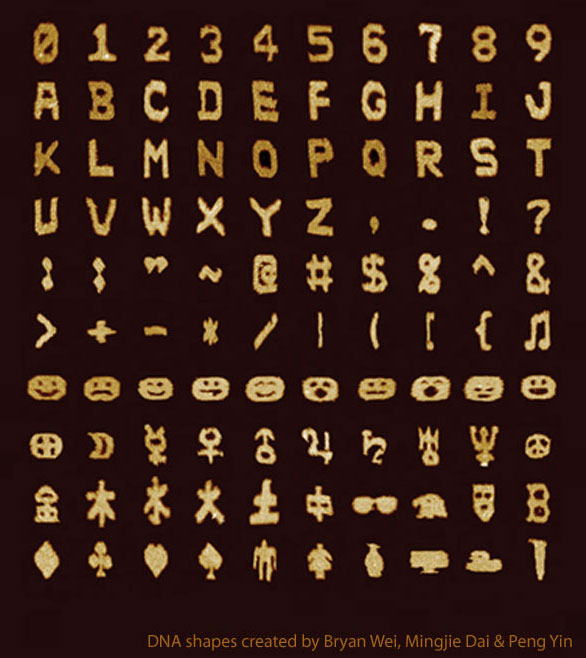
DNA Sans, a typeface / character set of self-assembled DNA strands that have been shaped into pixel-like blocks. I know where I’m stashing my next steganographically-hidden secret message! (Or maybe this could be used as graffiti for the Fantastic Voyage crew?)
(Via Nature – article is here for those with journal access)
-
Brian Moriarty Listen
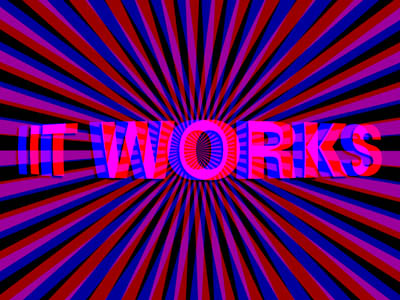
Game designer Brian Moriarty delivered quite a talk at the 1997 Game Developers Conference, touching on everything from interaction design, emergent play, community-created art, creativity, self expression, and even an unexpected but interesting tangent about 101 Dalmatians. In hindsight, many of subjects he talks about would become evident over the next decade, from the Sims to Etsy to Minecraft to social networking. From Listen! The Potential of Shared Hallucinations:
Before we can learn, before we can grow, we have to be prepared to listen.
What does it mean, to listen?
The word is commonly understood to mean “attentive hearing.”
It has its etymological origin in the archaic verb, list.
“List!” they used to say. “Ssh! List! The wild boar is outside!”
But the verb “list” also means to tilt something to one side.
When a sea vessel leans to starboard or port, it is said to be listing.
So how did the word “list” turn into the verb “listen?”
Because when we try to hear something, we sometimes cock our heads in the direction of the sound.
So to listen means more than to hear attentively.
The word also implies a change of inclination.
A new slant.
To listen is to put ourselves into a receptive attitude.
A position to be re-aligned.
Also worth reading (the talk is also available for watching as a video in the GDC Vault) if you fondly remember the days of Hypercard, MUDs, and when text adventures reigned supreme on AOL, or if you like crazy 1990s Photoshop anaglyphs…
-
Walking with Coffee
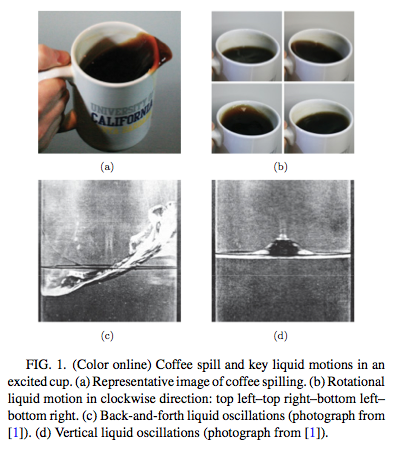
Perhaps as a counterbalance to the recent “coffee makes you live longer” news from that wacky New England Journal of Medicine, here’s more important science + beverage work ripped from the pages of Physical Review: Walking with coffee – Why does it Spill?
In our busy lives, almost all of us have to walk with a cup of coffee. While often we spill the drink, this familiar phenomenon has never been explored systematically. Here we report on the results of an experimental study of the conditions under which coffee spills for various walking speeds and initial liquid levels in the cup. These observations are analyzed from the dynamical systems and fluid mechanics viewpoints as well as with the help of a model developed here. Particularities of the common cup sizes, the coffee properties, and the biomechanics of walking proved to be responsible for the spilling phenomenon. The studied problem represents an example of the interplay between the complex motion of a cup, due to the biomechanics of a walking individual, and the low-viscosity-liquid dynamics in it.
Science!
(The full paper is also available for your Friday night reading fun. Via NCBI ROFL)
-
Wang Computers Commercial
The first computer at my house when I was a toddler was a Wang (presumably the 8088-based PC clone?) on loan from my dad’s job at AT&T, later replaced by the equally sexy Olivetti M24. All I remember about the Wang was that it had a letter guessing game called Wangman, and some kind of text-based dungeon / Adventure clone. And years later memories of it provided a good chuckle during an episode of the Simpsons (“Thank goodness he’s drawing attention away from my shirt!”). Unpopular computers FTW.
(Via John Nack)
-
Rives Bfk Acronym Explained

As an art person I’ve enjoyed a good amount of time around lithography and other drawing media, and now I’m engaged to a children’s book illustrator who largely works in watercolor, so I’ve spent a fair amount of time at art supply shops buying paper. One thing has bugged me for years about our fine rag paper purchases, though: what’s up with the “BFK” in “Rives Arches BFK”? I’ve asked professors, professional printers, other artists, and even the Internet, with no great leads, but I finally coaxed the answer out of Google today. From The Albumen & Salted Paper Book: The history and practice of photographic printing, 1840-1895:
It is no wonder that only two paper mills in the world managed to consistently produce a paper of the necessary quality, and these two mills were able to maintain their monopoly from the 1860’s until approximately World War I. They were the above-mentioned Blanchet Frères et Klébler Co. in Rives, France (hence their product was known as the “Rives” paper) and Steinbach and Company, located in Malmedy, Belgium (at that time part of Germany). Steinbach paper was known outside Germany as “Saxe” paper.
The product that established their paper monopoly (duopoly?) — the exploding new field of photography! More to the point, 3D stereography, the Victorian postcard origin of a Tumblr meme:
In the late 1850’s and especially after 1860, two new factors in photographic technology and practice generated a great demand for albumen paper. The first of these was the stereograph; its ability to transport the viewer to distant scenes with the illusion of three-dimensional reality depended largely on the smooth surface and fine detail of albumen paper. Stereo views were extremely popular, and created a corresponding demand for albumen paper. Nearly all stereo views before 1890 were made on albumen paper.
This 3D thing will catch on one of these days…
-
Orwell Life Simply Series of Defeats
Autobiography is only to be trusted when it reveals something disgraceful. A man who gives a good account of himself is probably lying, since any life when viewed from the inside is simply a series of defeats. George Orwell, Benefit of Clergy: Some Notes on Salvador Dali
-
Cat and Girl on Authenticity
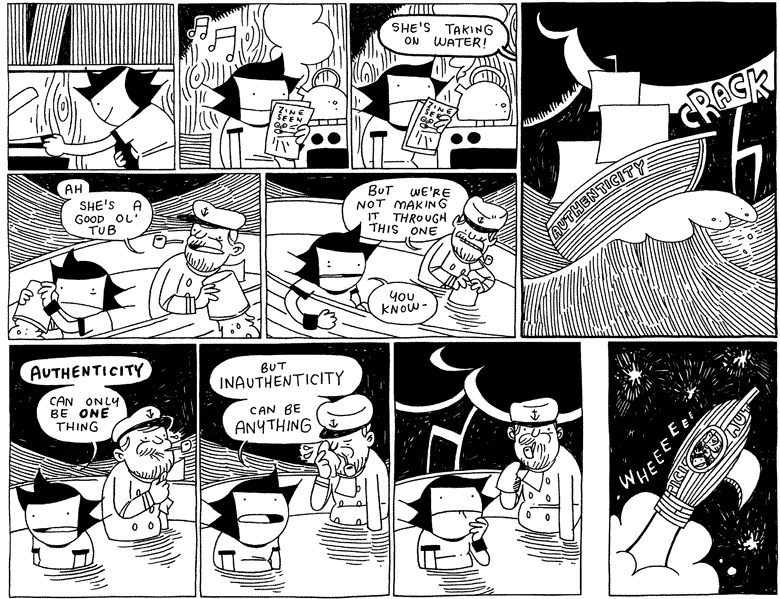
-
Austin 8bit Google Quest

Been having fun playing with Google Map’s Quest feature, creating some lo-fi Austin scenes. I’m sorry to say that this is likely a Google April Fools’ joke, as I kind of like poking around places as though they were background scenes from a forgotten third-tier Sierra adventure. I’ve posted a handful of Austin 8Bit pics on Flickr — what other locations would be good choices?
